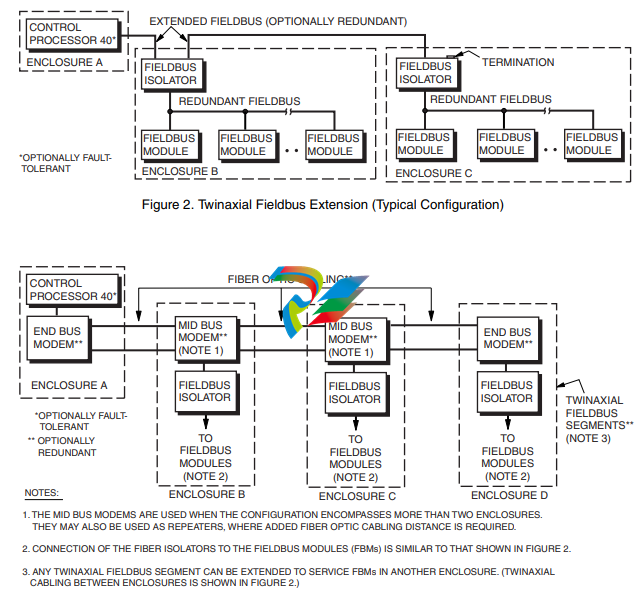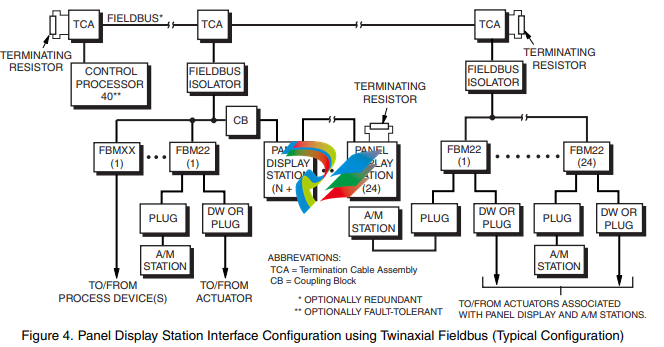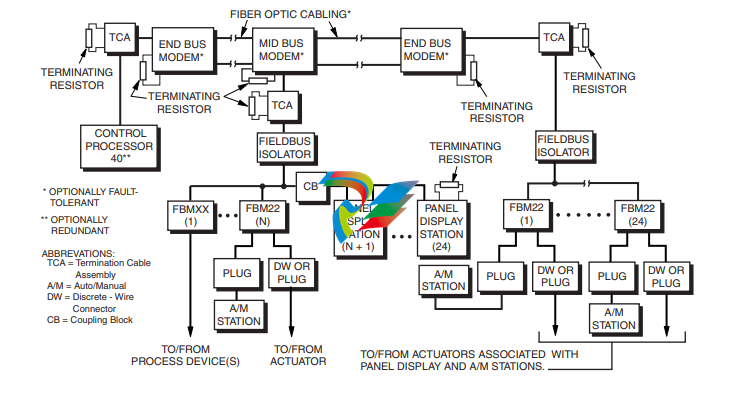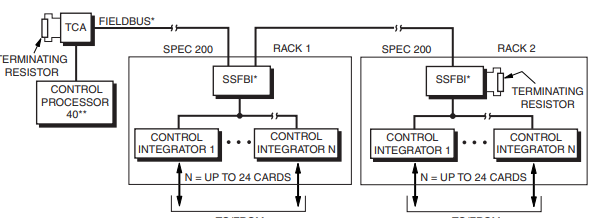
schneiderI/A Series® Hardware Control Processor 40
connect to each isolator.) The twinaxial Fieldbus
extension may be redundant.
• Fiber Optic Fieldbus Extension (Figure 3) - The
fiber optic Fieldbus can optionally extend the
distance as well as add application versatility and
security. Overall Fieldbus length can be up to
20 km (12.4 mi). Like the twinaxial Fieldbus
configuration, the fiber optic Fieldbus
configuration supports up to 64 Fieldbus Modules
(excluding expansion modules), up to 24
Modules per isolator.

All three Fieldbus configurations use serial data
communication complying with Electronic Industrial
Association (EIA) Standard RS-485. The data
transmission rate is 268.75 Kbps.
Panel Display Station Interfacing
The Control Processor 40 achieves the capability to
interface Panel Display Stations when the DSI (Panel
Display Station Interface) block is selected via the
configurator. In this capacity, the Control
Processor 40 can interface up to 24 Panel Display
Stations, or a combination of Fieldbus modules
(which may include associated Auto/Manual Stations)
and Panel Display Stations mixed on the same
Fieldbus. (Note, however, that per configuration rules,
one Panel Display Station counts as two Fieldbus
Modules.)
Control strategies should be planned such that all
blocks involved with the Panel Display Station,
Auto/Manual Station, and the control loops being
monitored or controlled are in the same Control
Processor 40, and ideally in the same compound.
The Control Processor 40 connects to the Panel
Display Stations and Fieldbus Modules via either of
two types of Fieldbus communications media:
twinaxial cable or fiber optic cable. Figure 4 shows a
typical twinaxial Fieldbus configuration, and Figure 5
shows a typical fiber optic Fieldbus configuration.
(Refer to Fiber Optic Fieldbus Product Specification
Sheet PSS 21H-7P1 B3 for additional fiber optic
Fieldbus application information.)
Cluster I/O Subsystem Interfacing
The Control Processor 40 interfaces with the Fieldbus
Cluster Input/Output Subsystem that consists of the
Fieldbus, a multi-slot chassis configuration of a
Fieldbus Processor (FBP10), analog/digital Fieldbus
Cards (FBCs), and power supply and power monitor
card. These Cluster I/O subsystems meet the needs
of applications where a high number of channels per
card are required. Figure 6 shows a typical twinaxial
Fieldbus configuration. (Refer to the Fieldbus Cluster
I/O Subsystem PSS 21H-2T1 B3 for additional
information.)


SPECTRUM Migration Interfacing
The Control Processor 40 interfaces with a
SPECTRUM Migration Integrator subsystem via a
single or redundant I/A Series Fieldbus and a
Fieldbus Processor (FBP) with built-in FBP isolator
located within the subsystem. There are four different
FBP integrators to accommodate Unit Control
Modules (UCM), Field Input/Output Units (FIO),
Universal Field Multiplexers (UFM), and Universal
Input/Output Units (UIO).
The CP40 control strategy can include any of
following SPECTRUM configurations:
• a single SPECTRUM Migration Integrator
subsystem
• multiple types of SPECTRUM Migration
Integrator subsystems
• Fieldbus Modules (FBMs) and/or other Fieldbusbased process interface subsystems along with
the SPECTRUM Integrator subsystem(s)
Control is via the software resident in the FBP
Integrator and in the SPECTRUM I/O Equipment
Control Blocks (ECBs) operating at the CP level.
Figure 7 illustrates a typical configuration with
multiple types of Integrator subsystems with nests of
I/O cards. (Refer to PSS 21H-7Q1 B3 SPECTRUM
Migration Integrators for additional information.)

Figure 7. Twinaxial Fieldbus SPECTRUM Migration Subsystem Interface Configuration (Typical Configuration)
SPEC 200 Control Interfacing
For migration of SPEC 200 control to I/A Series
Systems, the Control Processor 40 interfaces via a
single or redundant I/A Series Fieldbus with the
SPEC 200 Control Integrator subsystem. This
subsystem consists of individual Control Integrators,
and Fieldbus Isolators attached within the SPEC 200
rack.
Control is via the software resident in the Control
Integrator and in the SPEC 200 I/O Equipment
Control Blocks (ECBs) operating at the CP level.
Figure 8 illustrates a typical configuration with
multiple Control Integrators in the SPEC 200
subsystem. (Refer to PSS 21H-7R1 B3 SPEC 200
Control Integrators for additional information.)

Figure 8. Twinaxial Fieldbus SPEC 200 Control Subsystem Interface Configuration (Typical Configuration)
SPEC 200 MICRO Control Interfacing
For migration of SPEC 200 MICRO control to
I/A Series systems, the Control Processor 40
interfaces via a single or redundant I/A Series
Fieldbus with the SPEC 200 MICRO Control
Integrator subsystem. This subsystem consists of
individual Control Integrators, and Fieldbus Isolators
attached within the SPEC 200 MICRO rack (NCM or




























































































































